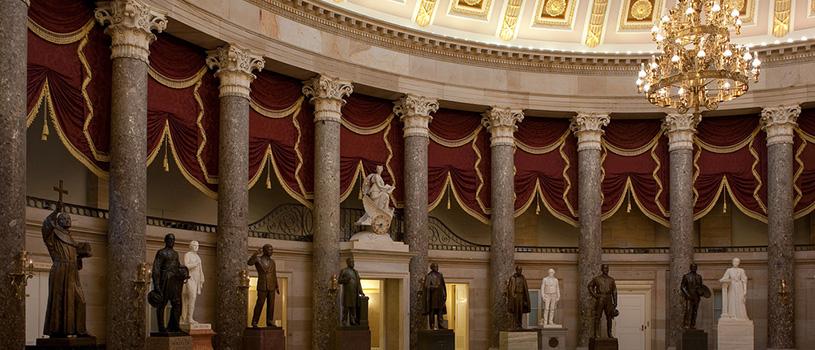Women in Statuary Hall


National Statuary Hall in the United States Capitol building in Washington, D.C., contains 100 statues – two from each state. Of that total, nine are women. In this month’s column we feature Jeannette Rankin (Montana), Dr. Florence Sabin (Colorado), Sakakawea (North Dakota – whom we often know as Sacagawea), Frances Willard (Illinois), Sarah Winnemucca (Nevada) and Helen Keller (Alabama), all of whom have been inducted into the National Women’s Hall of Fame. The other three women represented by statues are Mother Joseph (Washington), Esther Hobart Morris (Wyoming) and Maria Sanford (Minnesota).
 The first woman elected to the United States Congress, before women nationally had the right to vote, Jeannette Rankin won her election to the U.S. House of Representatives in 1916, representing Montana. Taking her seat in 1917 she was a committed pacifist who was lobbied heavily by the women’s suffrage leaders to support the call for the U.S. to enter World War I. A woman who stayed true to her ethics and values, Rankin was one of the few members of Congress to vote against entry, even though she was told that by doing so she would demonstrate to the country that women, of whom she was the sole representative, did not support the war effort. Her subsequent run for the U.S. Senate was not successful. In 1940, however, she did win the election to represent Montana in the U.S. House of Representatives. In 1941, she was the only member of Congress to vote against the U.S. entry into World War II. Rankin famously said, “We’re half the people; we should be half the Congress.” As we all know, that reasonable goal has yet to be achieved.
The first woman elected to the United States Congress, before women nationally had the right to vote, Jeannette Rankin won her election to the U.S. House of Representatives in 1916, representing Montana. Taking her seat in 1917 she was a committed pacifist who was lobbied heavily by the women’s suffrage leaders to support the call for the U.S. to enter World War I. A woman who stayed true to her ethics and values, Rankin was one of the few members of Congress to vote against entry, even though she was told that by doing so she would demonstrate to the country that women, of whom she was the sole representative, did not support the war effort. Her subsequent run for the U.S. Senate was not successful. In 1940, however, she did win the election to represent Montana in the U.S. House of Representatives. In 1941, she was the only member of Congress to vote against the U.S. entry into World War II. Rankin famously said, “We’re half the people; we should be half the Congress.” As we all know, that reasonable goal has yet to be achieved.

The first woman elected to the National Academy of Sciences (1925), Dr. Florence Sabin grew up in Colorado. A woman of many firsts, she was educated at Smith College before entering medical school at Johns Hopkins University (1896). Sabin excelled at laboratory work and published her first paper while still a medical student. The first woman faculty member at the Johns Hopkins School of Medicine and an outstanding scientist, she was nevertheless passed over for promotion to department chair. After students protested, she became the first full woman professor in the school of medicine. Her scientific work included focus on blood and blood systems as well as the brain and tuberculosis. In 1924, she became the first woman to serve as president of the American Association of Anatomists. After her retirement, she returned to Colorado and worked in the area of health reform. The public health laws passed due to her efforts were called the Sabin program. She received the Lasker Award for her efforts and has been inducted into the Colorado Women’s Hall of Fame.

Known to many of us as Sacagawea, Sakakawea was a Lemhi Shoshone woman who was the daughter of a Shoshone Chief. She was bilingual and she accompanied the Lewis & Clark expedition with her infant son where she served as guide and interpreter. Remembered for her cool-headedness in rescuing papers and supplies from a capsizing boat, her presence indicated to other Native Americans along the trail that the expedition was peaceful. Sakakawea’s likeness appeared on a U.S. dollar coin.

Active in both the temperance and suffrage movements, Frances E. Willard’s efforts were instrumental in the passage of both the Eighteenth (Prohibition) and Nineteenth (Women’s Suffrage) Amendments to the U.S. Constitution. Educated to be a teacher, as was common in the mid-1800s, Willard was appointed President of Evanston College in 1871. After a time as Dean of Women at Northwestern University, Willard turned her attention to the temperance movement. She helped found the Women’s Christian Temperance Union in 1874 and served as its president from 1879 until her death in 1898. Because women had no control of property and no rights within a marriage, the effects of alcohol could be devastating within a family – leading to violence against the wife and children, as well as economic deprivation. Thus a focus on temperance paired well with a focus on suffrage – and fighting for women’s rights. She remained an advocate for both throughout her life.

Northern Paiute Native American Sarah Winnemucca was born in Nevada and educated in California. In 1865, while she was away from the tribe, her mother and other family members were killed by the U.S. Cavalry. As a result, Winnemucca became an advocate for the rights of Native Americans, speaking across the country and lobbying the U.S. Congress. Her book, Life Among the Paiutes: Their Wrongs and Claims, published in 1883 is both a memoir and a history of her people. She gave many lectures around the U.S. after the book’s publication. She subsequently returned to Nevada and started a school for Native American children.

Rendered blind and deaf when she was 19 months old, Helen Keller’s intelligence and capabilities were redirected when at seven years old, she learned to communicate with sign language through the help of her teacher and later life-long companion, Anne Sullivan (Macy). A graduate of Radcliffe College and an advocate for individuals with disabilities, Keller served as an inspiration to disabled people the world over. Her story was popularized through the play and movie The Miracle Worker. An author as well as a speaker, Keller traveled the world speaking. One of the founders of the American Civil Liberties Union, Keller was also an advocate for women’s rights and birth control. She has been inducted into the Alabama Women’s Hall of Fame and the Alabama Writers Hall of Fame.
The statues of these amazing women are part of the National Statuary Hall Collection. They and many other women – almost all of them women we have not heard about and not learned about in school – across all fields of endeavor – more than 850 all together – are profiled in our book, Her Story: A Timeline of the Women Who Changed America. Help us by continuing to tell women’s stories and write women back into history!




